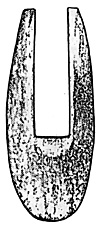
It is not at all difficult to finish off the reproduction India Pattern properly. All that one requires is a Workmate (the bench not an assistant), a selection of small files and various grades of sandpaper and emery paper, a junior hacksaw and some stuff for finishing the stock (of which more later). The first step is to strip the musket down into the three traditional component parts; lock, stock and barrel. In many cases the steel is not hard enough to produce enough sparks when struck by the flint so if this is the case send it off to the supplier with a polite but very firm request that it be made good. If it does not work as it should it is his responsibility to fix it or provide a suitable replacement.
Lay out all parts removed, including screws and pins in a logical manner so that when the time comes to put it all back together everything will also back exactly where it came from. Screws and pins may look the same but they will always fit better into the holes they came from. Do not assume they are interchangeable.
Having removed the lock by unscrewing the two sidenails the barrel should be dismounted. First withdraw the ramrod and unscrew the barrel tang and the forward sling swivel, then knock out the three pins which are evenly spaced along the stock. Leave the three sets of double pins as they are holding the ramrod pipes.
The barrel should then be cleaned and laid aside. With it out of the way the screw holding the fore-end cap in place will be exposed and can be removed.
The fore-end cap is of the wrong style, conforming to the New Land Pattern and the prominent lip at the rear needs to be removed. This is easily accomplished with the aid of hacksaw, files and emery paper but take care that it is not deformed by the vice. (see sketch)
Next replace the forward sling swivel, (but not the barrel) and place the stock in the Workmate. It is most easily gripped by the lock flat and forward sling swivel. Place the template supplied on the stock behind the breech and draw around it. IMPORTANT: The template is asymmetrical and the narrow side goes next to the lock. ne pencil line should now be incised using the sharp edge of a small half-round file and then the stock profile lowered around it by about 1/16th of an inch using an ordinary file. Use sand and emery paper to clean it up afterwards.
The raised portion remaining can also be hollowed out slightly but take care not to overdo this. That done move back to the butt. The comb of the stock is flat and rather too wide but this can easily be cured with a file and some sandpaper.
Now turn the stock on its side - lock side up. The lock flat is once again not quite the right shape and needs to be worked on with the round side of a file to create the tear-drop "finial" behind the lock. Having done this, before finishing off with sandpaper make a template to mark out the other side. (it is quite easy to get the shape right by following the contour of the lock but no such guide of course exists on the other side)
Having seen to both sides it only remains to return to the fore-end. Having removed the lip of the fore-end cap the stock will have quite a sharp cut-off and this needs to be rounded off. Fit the fore-end cap into place and draw round it to give a guide line.
Having done all this and, if your purse is up to it, arranged for the appropriate marks to be engraved on lock-plate and barrel, only one job remains to be done before re-assembling the musket. The stock where altered will need to be oiled and waxed to restore its finish. Personally I used Birchwood Casey Tru-Oil and Gun Stock Wax but there are various similar preparations available.
All that now remains to be done is to re-assemble it in the reverse order to which it was taken down. A final polish and there we are.
Inferior to the Short Land Pattern? Not a bit of it and the result is far more satisfying.
India Pattern Musket, 1779-1848 Part 1
Back to 18th C. Military Notes & Queries No. 6 Table of Contents
Back to 18th Century Military Notes & Queries List of Issues
Back to Master Magazine List
© Copyright 1999 by Partizan Press
This article appears in MagWeb (Magazine Web) on the Internet World Wide Web.
Other military history articles and gaming articles are available at http://www.magweb.com